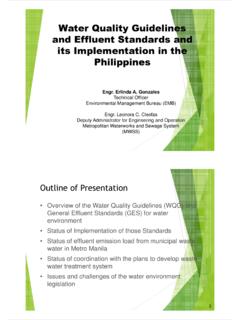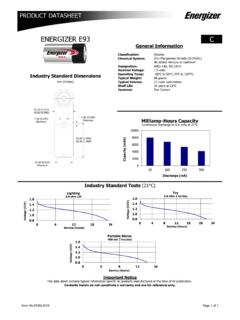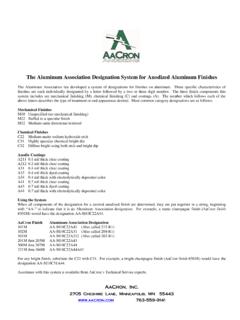Transcription of Water Quality-Based Effluent Limits
1 Chapter 6 Water Quality-Based EffluentLimitsPermit writers must consider the impact of every proposed surface waterdischarge on the quality of the receiving Water . Water quality goals for a Water bodyare defined by State Water quality standards . A permit writer may find, by analyzingthe effect of a discharge on the receiving Water , that technology- based permit limitsare not sufficiently stringent to meet these Water quality standards . In such cases, theCWA and EPA regulations require development of more stringent, Water quality -basedeffluent Limits (WQBEL) designed to ensure that Water quality standards are met. Inorder to develop effective WQBELs, permit writers must be familiar with State waterquality standards methods for predicting Water quality impacts from discharges, andprocedures for establishing WQBELs. This chapter provides basic information onthese subjects.
2 For more detailed information on Water Quality-Based permitting, referto theTechnical Support Document for Water Quality-Based Toxics Control(TSD),13or equivalent State or regional (1991).Technical Support Document for Water Quality-Based Toxics Control. EPA-505/2-90-001. Office of Water Enforcement and Permit Writers Manual - 87 Chapter 6 Water Quality-Based Effluent Overview of Water quality StandardsWQBELs involve a site-specific evaluation of the discharge and its effect on thereceiving Water . A WQBEL is designed to protect the quality of the receiving Water byensuring that State Water quality standards are met. To understand how to developWQBELs, the permit writer must understand State Water quality standards and thewater quality goals they 303(c) of the CWA requires every State to develop Water qualitystandards applicable to all Water bodies or segments of Water bodies that lie within theState.
3 Once standards are developed, EPA must approve or disapprove them. Waterquality standards should (1) include provisions for restoring and maintaining thechemical, physical, and biological integrity of State waters, (2) provide, whereverattainable, Water quality for the protection and propagation of fish, shellfish, andwildlife and recreation in and on the Water ( fishable/swimmable ), and (3) consider theuse and value of State waters for public Water supplies, propagation of fish andwildlife, recreation, agriculture and industrial purposes, and navigation. Currently,States are required to review their Water quality standards at least once every threeyears and revise them as necessary. When writing a permit, the permit writer mustuse the most current State Water quality standards . For more information regardingprocedures for developing Water quality standards , refer to EPA s Water QualityStandards Regulation at 40 CFR Part 131 and theWater quality StandardsHandbook: Second 510 of the CWA, States may develop Water quality standards morestringent than required by the Water quality standards Regulation.
4 Also, EPA reviewsand approves or disapproves State-adopted Water quality standards . EPA s review isto ensure that the State Water quality standards meet the requirements of the CWAand the Water quality standards Regulation. EPA may promulgate a new or revisedstandard for a State where necessary to meet the requirements of the (1994). Water quality standards Handbook: Second Edition. EPA of -NPDES Permit Writers ManualWater Quality-Based Effluent LimitsChapter Components of Water quality StandardsWater quality standards are composed of three parts: Use classifications Numeric and/or narrative Water quality criteria Antidegradation of these three components is described ClassificationThe first part of a State s Water quality standard is a classification system forwater bodies based on the expected beneficial uses of those Water bodies. The CWAdescribes various uses of waters that are considered desirable and should beprotected.
5 These uses include public Water supply, recreation, and propagation of fishand wildlife. The States are free to designate more specific uses ( , cold wateraquatic life, agricultural), or to designate uses not mentioned in the CWA, with theexception of waste transport and assimilation which is not an acceptable designateduse (see 40 CFR (a)). Designated uses should support the fishable/swimmable goal of Section 101(a)(2) of the CWA where such uses are attainable. AState must perform a use attainability analysis under 40 CFR (j) where it: (1)does not designate a fishable/swimmable use for a Water ; (2) wishes to remove a fishable/swimmable designated use; or (3) wishes to adopt subcategories of adesignated fishable/swimmable use that would require less stringent criteria. Theuse attainability analysis is a structured scientific assessment of the factors affectingthe attainment of a use.
6 The analysis may include physical, chemical, biological, andeconomic factors as described in 40 CFR (g). Water quality CriteriaThe second part of a State s Water quality standard is the Water quality criteriadeemed necessary to support the designated uses of each Water body. Section303(a-c) of the CWA requires States to adopt criteria sufficient to protect designateduses for State waters. These criteria may be numeric or narrative. The CWA requiresStates to adopt numeric criteria for certain toxic pollutants where they are necessaryto protect designated uses. EPA s Water quality standards Regulation encouragesNPDES Permit Writers Manual - 89 Chapter 6 Water Quality-Based Effluent LimitsStates to adopt both numeric andnarrative Water quality criteria. See Section ,Establishing Water quality Criteria, of this manual for additional information on thedevelopment of numeric and narrative PolicyThe third part of a State s Water quality standard is the State s antidegradationpolicy.
7 Each State is required to adopt an antidegradation policy consistent withEPA s antidegradation regulations (40 CFR ) and to identify the methods it willuse for implementing the policy. Antidegradation policies provide three tiers ofprotection from degradation of Water quality : Tier 1 Protects existing uses and provides the absolute floor of waterquality for all waters of the United States. Existing instream Water uses arethose uses that were attained on or after November 28, 1975, the date ofEPA s first Water quality standards Regulation, or uses for which existingwater quality is suitable unless prevented by physical problems such assubstrate or flow. Tier 2 Protects the level of Water quality necessary to support propagationof fish, shellfish, and wildlife and recreation in and on the Water in watersthat are currently of higher quality than required to support these Water quality in Tier 2 waters can be lowered, there must be anantidegradation review consisting of: (1) a finding that it is necessary toaccommodate important economical or social development in the areawhere the waters are located; (2) full satisfaction of all intergovernmentalcoordination and public participation provisions; and (3) assurance that thehighest statutory and regulatory requirements for point sources and bestmanagement practices for nonpoint sources are achieved.
8 Furthermore, Water quality may not be lowered to less than the level necessary to fullyprotect the fishable/swimmable uses and other existing uses. Tier 3 Protects the quality of outstanding national resources, such aswaters of national and State parks and wildlife refuges and waters ofexceptional recreational or ecological significance. There may be no newor increased discharges to these waters and no new or increaseddischarges to tributaries of these waters that would result in lower waterquality (with the exception of some limited activities that result in temporaryand short-term changes in Water quality ).90 -NPDES Permit Writers ManualWater Quality-Based Effluent LimitsChapter 6 Additional information on Water quality standards is available in theWater QualityStandards Handbook: Second Establishing Water quality CriteriaWater quality criteria set ambient levels of individual pollutants or parameters,or describe conditions of a Water body that, if met, will generally protect thedesignated use of the Water .
9 Water quality criteria are developed to protect aquaticlife and human health, and, in some cases, wildlife from the deleterious effects ofpollutants. Section 304(a) of the CWA directs EPA to publish Water quality criteriaguidance to assist States in developing Water quality standards . EPA criteria orguidance consists of three components: Magnitude The level of pollutant (or pollutant parameter), generallyexpressed as a concentration, that is allowable. Duration The period of time (averaging period) over which the instreamconcentration is averaged for comparison with criteria concentrations. Frequency How often criteria can be s efforts on criteria development have been focused on the 65 pollutantslisted in Section 307(a) of the CWA. Some of the 65 pollutants on the list are actuallyfamilies or classes of organic compounds consisting of many individual translated this list into a new list of 129 priority toxic pollutants.
10 Subsequently,two volatile chemicals and one Water unstable chemical were removed from the list sothat the present list contains 126 priority toxic pollutants. Criteria for the priority toxicpollutants that EPA has developed to date are contained in individual criteriadocuments and summarized in a document entitledQuality Criteria for Water 1986,16more commonly referred to as theGold (1994). Water quality standards Handbook: Second Edition. EPA 823-B-94-005a. Office (1986). quality Criteria for Water , 1986. EPA-440/5-86-001. Office of Water Regulationsand Permit Writers Manual - 91 Chapter 6 Water Quality-Based Effluent LimitsNumeric CriteriaNumeric Water quality criteria are values expressed as levels, constituentconcentrations, toxicity units (see discussion of whole Effluent toxicity below), ornumbers deemed necessary to protect designated uses. These criteria often form thebasis for NPDES WQBELs.



















